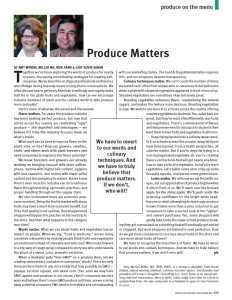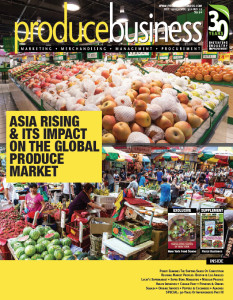NOTE TO READERS: A shorter version of this article originally appeared in the December 2015 issue of Produce Business magazine.
By Amy Myrdal Miller and Suvir Saran
Together we’ve been exploring the world of produce for nearly 10 years, discussing and debating strategies for creating deliciousness. We’ve done this on stage at professional conferences, and offstage during leisurely meals or long phone conversations. We often discuss how to get every American to willingly and eagerly make half his or her plate fruits and vegetables. And how can we get more professionals—on both the produce and culinary side—to take produce more seriously? We all know it’s good for us, but how do we get everyone to seek more produce at every meal and snack?
Here’s some of what we’ve discussed and discovered.
Flavor matters. For years the produce industry has been seeking perfect produce, but now that stores across the country are celebrating ugly produce—the imperfect and misshapen—we believe it’s high time the industry focuses more on what’s inside.
What more can be done to improve flavor on the plant, vine, or tree? How can growers, retailers, chefs, and others work with plant breeders and seed companies to maximize the flavor potential of produce?
 We know plant breeders and growers are already working on bringing to market broccoli with more sulforaphane, melons with higher brix content, peppers with less capsaicin, and onions with lower sulfur content and less pungency. But we know there’s even more the industry can do to enhance flavor through breeding, agronomic practices, and proper handling throughout the supply chain.
We know plant breeders and growers are already working on bringing to market broccoli with more sulforaphane, melons with higher brix content, peppers with less capsaicin, and onions with lower sulfur content and less pungency. But we know there’s even more the industry can do to enhance flavor through breeding, agronomic practices, and proper handling throughout the supply chain.
We also understand there are economic pressures involved in all of this. Being the first to market with stone fruits may have a short term economic benefit, but if the fruit quality is not optimal, that disappointed shopper will bypass the peaches on her next trip to the store. And then what happens to that category over time?
If we all commit to enhancing flavor and deliciousness, we may have some impact on changing produce consumption in this country. But there’s more we need to do.
Words matter. What we say about fruits and vegetables has an impact on people. When we say, “Food is medicine,” are we doing ourselves a disservice by making people think fruits and vegetables are medicinal instead of craveable and delicious? Who looks forward to a big swig of cough syrup compared to everyone who understands the allure of a sweet, juicy, aromatic nectarine.
When a marketer puts “non-GMO” on a produce item, are we creating unnecessary confusion in the consumers’ minds? There are only three produce items in any store today that may possibly be GMO—papaya, zucchini squash, and sweet corn. (Yes, soon we may have GMO apples and potatoes in our stores.) But if consumers become wary and believe there’s more GMO produce out there, are we scaring away potential consumers? We need to be truthful and not misleading with our marketing claims. The Food & Drug Administration requires this…and our shoppers deserve this.
When we discuss flavors and textures and use rich descriptive language like, “the crispy, caramelized edges of the roasted sweet potato”, people lean in. They listen. Their mouths start to water as they anxiously await their first bite. But when a waiter describes a vegetable accompaniment as “seasonal vegetables” our interest wanes. What kinds of vegetables? How were they prepared? Why should I care?
Culinary techniques matter. We can’t count the number of times we’ve texted each other from restaurants or cavernous hotel ballrooms when a plate with steamed vegetables has appeared in front of one of us. Steamed vegetables are sometimes okay but rarely great. We have to get people in kitchens across this country—both professional and home kitchens—to give fruits and vegetables the respect they deserve when it comes to culinary techniques and flavor development strategies.
Roasting vegetables enhances their flavor, caramelizing the natural sugars, and making the texture more desirous. Roasting vegetables is easy. We want to see more K-12 schools across the country offering roasted vegetables to students. Yes, salad bars are great, but they’re most often filled with raw fruits and vegetables. There’s a whole world of flavors and textures we need to introduce to students if we want them to love fruits and vegetables in all of their forms.
Speaking of raw vegetables, they too take careful thought and effort. Making slaws with mixtures of raw vegetables can brighten colors and improve the texture. Adding some avocado or nuts adds some additional flavor and texture notes that make the slaw more interesting, something you want to revisit a few times. A slaw made with green cabbage and coleslaw dressing is like listening to a three year-old repeatedly pressing middle C on a piano. A slaw made with green cabbage, red cabbage, carrots, bell peppers, herbs, and peanuts with a sweet yet tangy citrus vinaigrette is like listening to a symphony…or your favorite rock band.
Deep frying has become a culinary swear word, and in K-12 schools across this country deep fat fryers have been banned. From a health perspective, all calories matter. But if you’re deep fat frying in a non-hydrogenated vegetable oil, you’re creating flavors and textures that will get nearly any American to take a bite of a vegetable. So let’s fry more vegetables! Let’s batter some okra, crisp up some Brussels sprouts, and devour some green beans!
Looks matter. We all know we eat first with our eyes, but our appreciation of produce begins when it sits in front of us. We’ll reach over the bruised apple for the perfect apple. We’ll push aside the browning cauliflower for the gleaming white head. Anyone in retail attempting to move ugly produce knows it takes more than a price reduction to get consumers to take a second look at the “uglies” and place them in their carts. Yes, some shoppers will gladly take home the lower priced produce, knowing they got a great deal on something that will eventually get peeled and chopped. But most shoppers have been trained to seek perfection. How do we get more consumers to care less about looks in the store and care more about looks at home?
How do we get Americans to make half their plates fruits and vegetables? We have to recognize the importance of flavor. We have to go back to our words and culinary techniques. And we have to truly believe that produce matters. If we don’t, who will?
Amy Myrdal Miller, MS, RDN, FAND, is a farmer’s daughter from North Dakota, award-winning dietitian, culinary nutrition expert, and founder and president of Farmer’s Daughter Consulting LLC. Suvir Saran is an award-winning chef and restaurateur. Born in Delhi, India, today Suvir lives on a farm in upstate New York. His next restaurant is scheduled to open in San Francisco in 2016.


